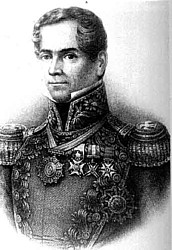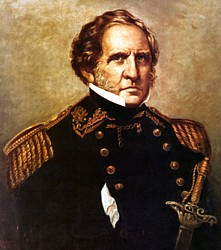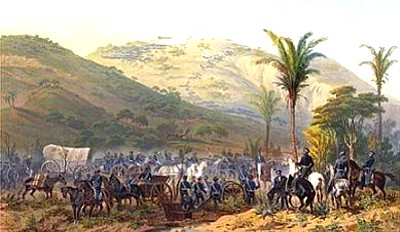Cerro Gordo County Iowa
Part of the IaGenWeb Project
|
Mexican War 1846 ~ 1848
In 1844, Santa Anna was made dictator of Mexico, only to be deposed and exiled a
year later. On July 4th of 1845, Texas consented to be annexed to the United States and joined the Union on
December 29, 1845. In response, the Mexican minister to the United States lodged a formal protest and asked
for his passport. The Mexican Senate broke relations with the United States, and, on March 28, 1845, gave President
Jose Joaquin HERRERA the authority to raise troops in preparation for war. Newly elected President James POLK
ordered American Army toops to the border and prepared to send Navy ships to the Mexican coast. However, POLK sent
John SLIDELL to Mexico for one last effort of establishing peace with HERRERA. Of prime importance
to both countries was the boundary
dispute between western Texas and Mexico. This border, throughout Spanish and Mexican history, had been the Nueces
River. The Congress of the Republic of Texas had re-established the border as the Rio Grande River in 1836.
The Mexican government never formally accepted the Rio Grande River as the border. When encamped at the
border of Mexico, General Zachary TAYLOR sent out a party of 70 dragoons, under the command of Captain Seth THORNTON,
to investigate an abandoned hacienda on April 25, 1846. They spied a small body of Mexicans about 25 miles from
the American encampment. THORNTON and his men charged, not knowing that a body of 2,000 Mexican soldiers were on
the other side of the hill. Sixteen Americans including Captain THORNTON were killed and 49 Americans were
taken prisoner and held at Matamoros, Tamauplipas. The incident became known as "The THORNTON Affair" of which gave
President James POLK cause to announce to Congress that hostilities had commenced. Congress declared war on
on May 13, 1846. Protesting at first, the Mexican government officially declared war on July 7, 1846.
The American strategy for assault upon Mexico was a three-pronged offensive. General Stephen W. KEARNY and the
Army of the West with 1,500 men would leave Fort Leavenworth to occupy New Mexico and California. DONIPHAN led
the Army of the Center to northern Mexico. Zachary TAYLOR led the Army of Occupation toward Mexico City.
The defeat of the Mexican Army at Palo Alto and Resaca de la Palma raised political turmoil in Mexico. Santa Anna
used this to revive himself and return from his Cuban exile. Arriving in Mexico City in mid-August of 1846, he offered
his services to the Mexican government. After his appointment as commanding general, Santa Anna
began to revitalize the army and within a few months assembled an army that was 25,000 strong. On February 22, 1847,
Santa Anna marched north with 20,000 men to personally engage TAYLOR and his 4,600 men at a mountain pass called
Buena Vista. Along the way, Santa Anna suffered the loss of desertions, arriving with 15,000 men. The Americans were
saved by artillery fire against the Mexican advance and by a charge from the mounted Mississippi Riflemen under
the command of Jefferson DAVIS. Suffering discouraging losses and hearing of upheaval in Mexico City, Santa Anna
withdrew that night, leaving Zachary TAYLOR in control of northern Mexico. The Battle of Buena Vista later led to
TAYLOR'S successful 1848 campaign to the American presidency.
General SCOTT and
8,500 healthy troops began a march westward toward Mexico City.
In a canyon near the village of Cerro Gordo, approximately half-way to Mexico City, Santa Anna set up a
defensive position with 12,000 troops and artillery trained upon the main road. Santa Anna believed that there was
no way around this pass. SCOTT, however, had sent 2,600
mounted dragoons under the command of General TWIGGS ahead of him. Santa Anna prematurely fired upon them, revealing the Mexican army's position.
Meanwhile SCOTT'S main body of troops under the command of Captain Robert E. LEE
had trekked through the rough terrain and located on higher ground,
quietly flanking the Mexican position. During the Battle of Cerro Gordo, April 17 - 18, 1847, the Americans suffered a loss of 431
killed and wounded. The Mexican Army suffered over 1,000 casualties with another 3,000 were taken prisoner. Santa Anna
was forced to flee back to Mexico City on foot. The Battle of Cerro Gordo opened the road to Mexico City for the Americans.
On February 2, 1848, American diplomat Nicholas TRIST signed the Treaty of Guadalupe Hidalgo, thus ending the Mexican
War. The treaty gave the American undisputed control of Texas, established the American-Mexican border of the Rio
Grande River, and ceded to the United States what would later become the states of California, Nevada, Utah, and
parts of Colorado, Arizona, New Mexico, and Wyoming. In return, the United States paid the Mexican government
$15,000,000 - less than half the amount the United States had offered for the land before the
onset of the Mexican War - and the United States agreed to assume $3.25 million in debt that the Mexican government
owed to American citizens. The acquisition and treaty was a source of great controversy at the time, particularly
among American politicians who had opposed the war from the start.
Throughout the remainder of Santa Anna's life, sometimes he was in power. At other times he lived in exile.
Eventually the the monies received from the Treaty of Guadalupe Hidalgo had been spent and the treasury was
depleated. Santa Anna sold more Mexican territory to the
United States, the Mesilla Valley in lower New Mexico and Arziona. The United States wanted the land to build a
new railroad in California. The purchase was made for $10 million, which alienated Santa Anna from his Mexican
liberal opposition. He was exiled for the eleventh and last time. Santa Anna died
in Mexico City in 1876 in poverty and neglect.
General Winfield SCOTT, born near Petersburg, Virginia, on June 13, 1786, began his military career in 1807 when he
enlisted in Petersburg cavalry troop. He served on the Niagara front during the War of 1812, was captured and paroled.
He commanded a troop during the Black Hawk War but didn't see service due to a cholera outbreak among his men. He
commanded field forces during the Second Seminole and Creek Wars of 1836. General SCOTT was the commanding general
of the United States Army when the Mexican War broke out. He held that position until November 1st of 1861 when he
retired from active service. General SCOTT was the unsuccesful Whig candidate for President in 1852, losing by 10,000
votes. He died on May 29, 1866 in West Point, New York.
Cerro Gordo County, Iowa, was named in honor of the Battle of Cerro Gordo of the Mexican War.
SOURCES:
|
© Copyright 1996-
Cerro Gordo Co. IAGenWeb Project
All rights Reserved.



 Antonio Lopez de Santa Anna (1794-1876) was the president of Mexico from 1833 to 1836. During this time he attempted to crush the
Texan Revolution and seize the Alamo in 1836. However Santa Anna was defeated and captured by Sam Houston at
San Jacinto on April 21, 1836.
Antonio Lopez de Santa Anna (1794-1876) was the president of Mexico from 1833 to 1836. During this time he attempted to crush the
Texan Revolution and seize the Alamo in 1836. However Santa Anna was defeated and captured by Sam Houston at
San Jacinto on April 21, 1836. On March 7, 1847, a force of 70 troopships under the
command of
General Winfield SCOTT arrived by sea at the port of Vera Cruz in preparation for an invasion of the Mexican heartland.
This army included Robert E. LEE, George MEADE, Ulysses S. GRANT and Thomas "Stonewall" JACKSON. After a 12-day siege,
the American troops captured Vera Cruz, however the men began to fall victim to yellow fever.
On March 7, 1847, a force of 70 troopships under the
command of
General Winfield SCOTT arrived by sea at the port of Vera Cruz in preparation for an invasion of the Mexican heartland.
This army included Robert E. LEE, George MEADE, Ulysses S. GRANT and Thomas "Stonewall" JACKSON. After a 12-day siege,
the American troops captured Vera Cruz, however the men began to fall victim to yellow fever.
